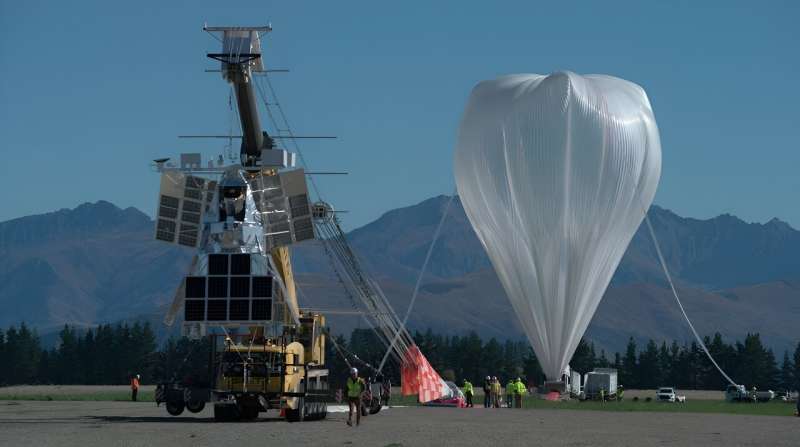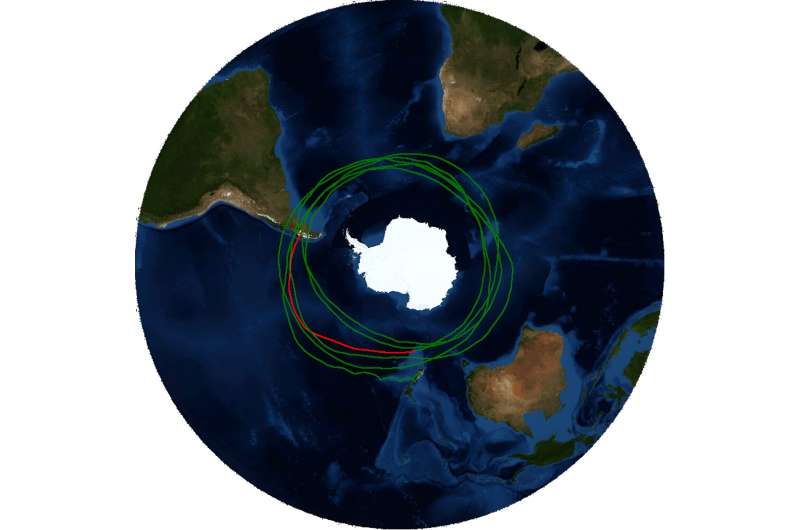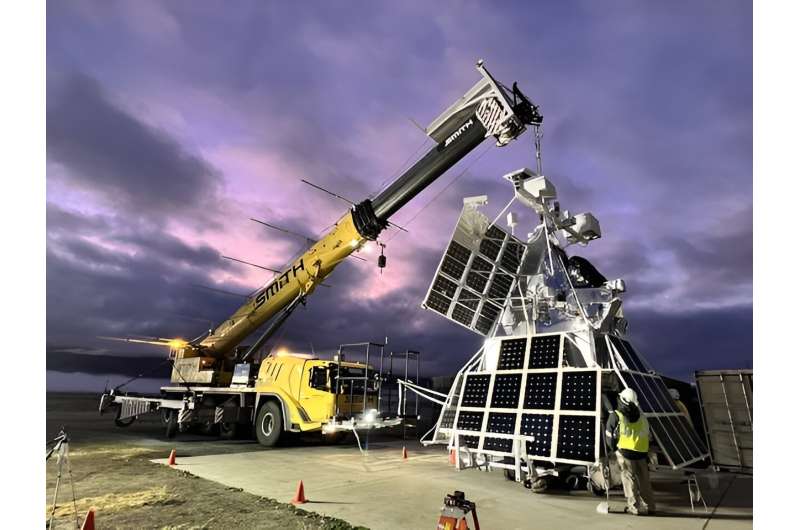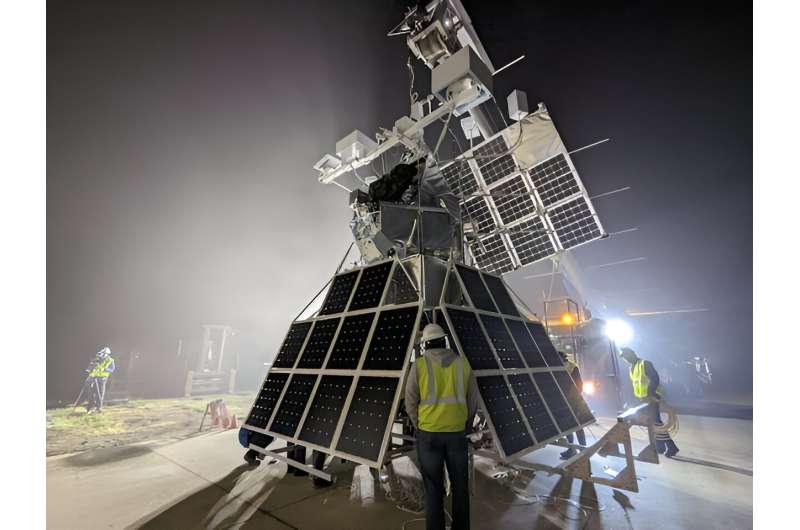This article has been reviewed according to Science X's editorial process and policies. Editors have highlighted the following attributes while ensuring the content's credibility:
fact-checked
trusted source
written by researcher(s)
proofread
How a balloon-borne experiment can do the job of the Hubble space telescope

An astronomical telescope designed to complement the aging Hubble Space Telescope lifted off from New Zealand's south island on April 16 2023. But as a sphere the size of a football stadium rose silently and slowly over the Tauhinukorokio mountains, calls started coming in from residents.
Local police and radio stations, however, had been briefed by Nasa that the giant helium balloon would lift the two-ton SuperBIT telescope to 40km above sea level, over the next three hours. The mission, in which we were involved, was to test whether a balloon-borne telescope could capture deep space images with high enough resolution to study the unknown substance, dubbed dark matter, that is 85% of all material in the universe.
The observations and subsequent data analysis have proved that balloon-borne experiments can be just as useful as those launched by rockets, but are much cheaper. It is now up to scientists, government agencies and private companies to make the most of them.
For the next month, polar stratospheric winds carried SuperBIT around the world every eight days, mainly over the Antarctic ocean but clipping the tip of South America. It went where the wind carried it, but could look in any direction.
Each day, solar panels recharged its batteries. At night, it photographed the sky, including the Tarantula nebula, a light source 160,000 light years away, and clusters of galaxies 20,000 times farther.
Without a tripod, SuperBIT used gyroscopes to stabilize any swinging (we discovered that the stratosphere is remarkably calm … except in turbulence above the Andes, where SuperBIT once dropped 1,000 feet). It was the first balloon-borne telescope to achieve Hubble-like performance for the short wavelengths of light that are visible to a human eye.

The balloon and the telescope continued to work perfectly, but satellite communication links gradually failed. We think radiation damaged SuperBIT's antennae. We could still download data by dropping hard drives, attached to the telescope, to the ground. But ultimately, Nasa wanted their balloon back, so we brought the telescope down by parachute to Argentina.
This was SuperBIT's fifth flight, building on ten years of graft.
Balloon benefits
Unlike orbital missions, if balloon payloads don't work first time, they can be fixed and relaunched. This fosters simple, creative design. Components now proven to work in space include hair gel (to hold things), chicken roasting bags (to keep them warm), and parts of bows used by Olympic archers (to let them go).
Failure and success are both opportunities to learn. After each flight, we make-do-and-mend, or improve the technology. For example, since cameras have rapidly got better and cheaper, we have fitted SuperBIT with a new sensor each year. All this reduces costs.
Most of the cost of traditional spaceflight is to mitigate the risk of failure. Compromises are always needed between safety, protecting expensive equipment and getting data.

If a balloon mission goes wrong, it usually matters less, because we get the equipment back. SuperBIT was built mainly by Canadian Ph.D. students, who have already spun-out a new tech company.
Risk management is different for balloons, and Nasa doesn't always get the balance right. Waiting for "perfect" weather and the perfectly designed balloon grounded all launches from Texas in 2017. Physically impossible calculations of risk, such as a balloon bursting three times, nearly tanked the 2023 program.
A balloon can only burst once. But France's and Canada's space agencies, the US National Center for Atmospheric Research and the UK Science Research Council have all proved that a balloon can be relaunched every few days. Risk assessment can be more realistic. Balloon teams can continually test, play around with and improve the process. For rocket launches, there is one chance only.
Growing international interest
Geography is important in developing a successful national balloon program. Countries with expansive landmass can carry out short flights within their own airspace, such as Canada and the US. Northern European countries can use stable and reliable summer winds to extend flights across the Atlantic ocean, for example from Scotland to Canada.
Countries can also launch from the territory of partner nations around the world, such as the UK launching from Australia.

Geopolitics also influences the choice of flight path: a lesson well learned from the rogue Chinese balloon that flew over the US in 2023 and was ultimately shot down. Crossing any country's airspace requires permission, and we avoid war zones or areas of conflict where the balloon could be mistaken for a hostile target. This is one reason we launched from New Zealand.
Government interest in national balloon programs is increasing, as new material science and manufacturing techniques have created balloons that retain helium, lengthening flights from days to months. The US reaffirmed their interest in a 2023 government paper and Canada, France and Sweden have long-established balloon programs.
The UK ran a world-leading balloon program until the 1990s. Abandoning it lost an opportunity to train scientists and engineers into leadership roles. British teams are still often invited to join French or US satellite missions, but we no longer lead or decide what gets built. We foresee few technical, geographic or political barriers to the UK restarting a balloon program in parallel to its nascent rocket launches.
Balloons are high enough
Officially, space begins 100km above sea level. But there is no magic line, and precious little atmosphere above 40km. There, stars stop twinkling and the sky is black. Long exposure astronomical photographs become pin sharp and reveal faint, distant objects that are blurred to astronomers on the ground.
Balloon cameras or spectrographs can also look down, and are high enough to capture Earth observations just like those from satellites. They can also take atmospheric measurements around them, including of the ozone layer in the stratosphere.
Balloons won't replace all rockets, as they can't travel higher than 40km. And even though helium is a finite resource, balloons are more "environmentally-friendly". They require no rocket fuels during launch, don't add to increasing space debris in orbit—and at the end of their working life, they aren't burnt up in the atmosphere. What's not to like?
Provided by The Conversation
This article is republished from The Conversation under a Creative Commons license. Read the original article.![]()




















